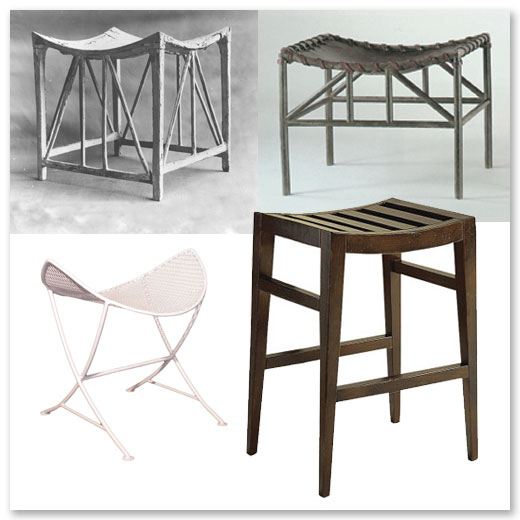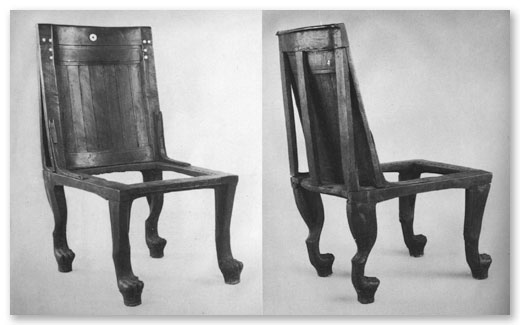As a student, when my thirst for research began, I was fascinated by how far back in time furniture was developed, assuming that “real” design began a couple hundred years ago.
I discovered that nearly all types of freestanding furniture are broken into two basic groups, the platform (tables, seating, beds) and the box (chests, cabinets, and cupboards). Although these two groups have gone through many stylistic interpretations, the basic forms have remained virtually unchanged for thousands of years.
But there is a place and time when the forms we are most familiar with today began to take shape. That place is Egypt 2560 BCE, around the time the Great Pyramid at Giza was built.
Egyptian furniture was held in such high regard that it was buried with members of royal families and aristocrat classes to be enjoyed in the afterlife. This photo of the tomb of Tutankhamen shows one of the three lioness-headed couches found lined up behind one another. In the foreground, two Thebes style stools whose design still appears in the chicest of homes.
Photos: © Griffith Institute, University of Oxford
This Thebes stool (above left), circa 1400 BCE, was discovered in the tomb of King Tutankhamun. Simple lines, lattice bracing and a double cove seat in white paint; this stool could not be more modern. A 1936 French Egyptian Revival stool (above right) by Marc du Plantier in bronze and braided leather and a circa 1960’s interpretation by Salterini (below left). J Black Design for Baker’s Milling Road collection (below right).
Photos: Above left, © Griffith Institute, University of Oxford; above right, Éditions Norma; below left © Full House; and below right, ©Baker Furniture.For all intents and purposes, the Egyptians invented cabinetmaking, including joinery details still used today: the mortise and tenon joint, the miter joint and the dovetail joint. These techniques alone allowed for the creation of durable, beautifully proportioned, pieces of furniture and were unrivaled anywhere else in the world. Design elements, silhouettes and pieces we (take for granted) think of as modern were incorporated in all types of forms.
Photo: The Woodwhisperer.Created 3300 years ago, this painted tall table has all the elements of “modern.” The refined art of joinery gave greater stability to frames of all kinds, allowing an elegant simplicity in appearance. During this period the Egyptians also advanced the art of turning, marquetry, inlay and veneers with wood and precious materials embellishing palace furniture.
Photo: Egyptian Museum, Cairo Egyptian stools evolved into the seat, what we call the chair today, with an inclined back and a curved top rail. Ergonomics 101. Higher seats dictated longer legs, so carpenters began to copy legs of animals, such as gazelles and lions, which would eventually morph into the cabriole leg. An 18th Dynasty (circa 1400 BCE) chair in hardwood with bone inlay.
Egyptian stools evolved into the seat, what we call the chair today, with an inclined back and a curved top rail. Ergonomics 101. Higher seats dictated longer legs, so carpenters began to copy legs of animals, such as gazelles and lions, which would eventually morph into the cabriole leg. An 18th Dynasty (circa 1400 BCE) chair in hardwood with bone inlay.
 The form of this Egyptian boudoir chest (left) which was used to store toiletries and jewelery, could be the forerunner of any number of 18th Century English box on stands (center) or a Paul McCobb chest on stand circa 1950 (right).
The form of this Egyptian boudoir chest (left) which was used to store toiletries and jewelery, could be the forerunner of any number of 18th Century English box on stands (center) or a Paul McCobb chest on stand circa 1950 (right).

Jar stands flourished, because as we do today, the Egyptians loved flowers. This Sycamore fig wood jar stand (above left) was painted with a motif of red, green and blue rectangles on a yellow background. The stand would support a jar in the open collar-shaped support held in place at the top of the stand. Above right: an 18th Century George III urn stand; below right, a 21st century adaptation by J Black Design for Henredon.
Photos: Above left, ©The Trustees of the British Museum; above right, Sotheby’s; below, ©Opus Photography.
The Egyptian bed, or couch (above), became the inspiration for the chaise longue (below) as it flourished after the real discovery of Pompeii and its sister city, Herculaneum, in 1738. The carved legs of the Egyptian couch represent the fore and hind legs of a lion, which face towards the head of the bed; the extending panel serves as the footboard.
Photos: Above, ©Griffith Institute, University of Oxford; below, Madame Récamier, ©Musée du Louvre/A. Dequier – M. BardAbove, a full-scale reconstruction (the original was gold plated wood) of the bed canopy and furnishings of Queen Hetepheres, 2500 BCE. Archeological fragments suggest the canopy was hung with linen drapery stored in the “curtain box,” foreground. Linen draperies protected royal sleepers from insects and provided privacy. The first “room-within-a-room?”
Photo: Museum of Fine Arts, BostonAs noted earlier, by primarily focusing on the archaeologica forms, not decoration or culture, we can see how our perception of modern forms may not be as modern as we think.
And how a few thousand years later and a few hundred miles to the north, by further refining techniques and materials first introduced in ancient Egypt, the most classical of all forms was born: the klismos.
Really nice and well done. Sort of the “Kitchen Confidential” of the furniture business.
John,
I believe the lady on the couch is Madame the Pompadour. It could also be Josephine de Beauharnais and then we are 100 years apart! Jet lag comment as I just landed in Hong Kong!
Jacques
Jacques
According to Wikipedia, the lady in David’s painting was in fact:
Jeanne-Francoise Julie Adelaide Bernad Récamier, or Juliette, who at 15 married a rich banker named Jacques Récamier, who some believe was actually her natural father. She was around 23 at the time of this painting and is why the chaise-longue, such as the one on which she reclines, is often called a récamier.
Another painting by Francois Gérard shows her in a similar pose, but on a shorter version of a Grecian inspired seat.